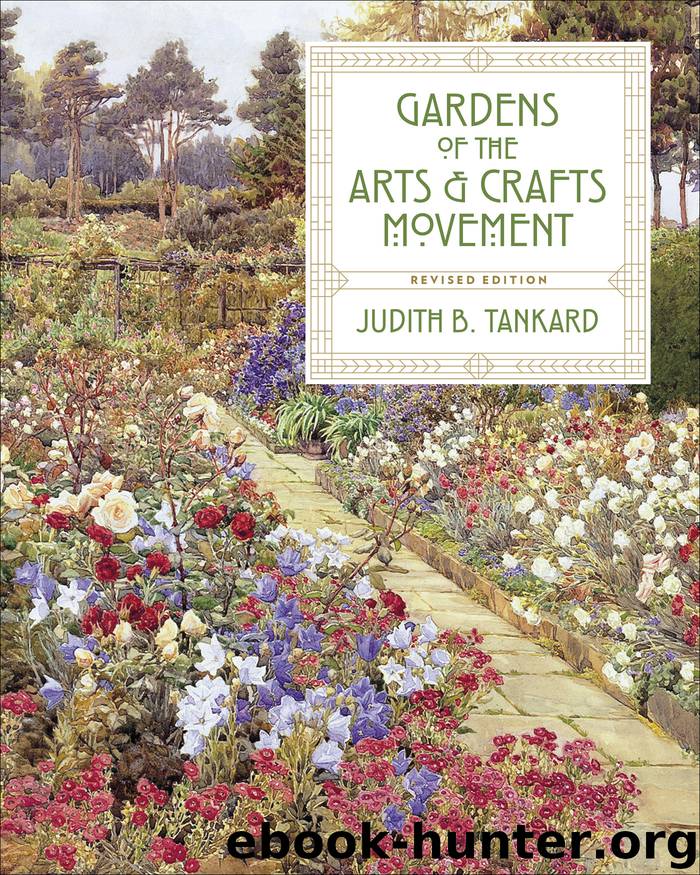Gardens of the Arts and Crafts Movement by Judith B. Tankard

Author:Judith B. Tankard
Language: eng
Format: epub
Publisher: Timber Press
Published: 2018-11-27T16:00:00+00:00
Frank Lloyd Wright and Ellen Shipman, Graycliff Estate, Derby, New York
Wright was not known for collaborating with landscape architects, but at the request of his clients, Darwin and Isabelle Martin, Ellen Shipman was invited to provide additional design input for the couple’s lakeside house near Buffalo, New York. Wright designed Graycliff in 1928–29, a volatile time for wealthy industrialists, many of whom lost their fortunes during the Great Depression. His initial designs for the grounds included sketches for the dramatic entrance water garden, which Shipman later modified, and other landscape features that she removed. The Martins’ decision to hire Shipman was based on her renown as a landscape architect. Her design scheme specified groups of trees and shrubs around the forecourt, a naturalistic evergreen garden filled with swaths of lilies, an intricate flower garden, and other areas of the steep lakefront property that rose seventy feet (twenty-one meters) above Lake Erie. In the end, Wright’s low, sweeping house in his later period Prairie-style architecture was beautifully complemented by Shipman’s landscape. It is an excellent example of how American designers embraced the principles of the Arts and Crafts Movement while respecting regional aesthetics and traditions.
Other, less famous Chicago architects were also influenced by the Arts and Crafts Movement. Howard Van Doren Shaw (1869–1926), who designed country houses in Lake Forest and other fashionable suburbs ringing Chicago, was a devoted Anglophile and conversant with his British contemporaries. Ragdale, Shaw’s summer house and country retreat for his growing family, is located in a once-rural farm property with an old apple orchard and views to acres of meadows. Today it is hailed as “one of the finest examples of Arts and Crafts architecture in America, because it has remained untouched and is well preserved.”12 The twin-gabled white stucco house, with low, sweeping roofs and wood shutters with heart motifs, bears a striking resemblance to Voysey’s own house, The Orchard, built the following year. The interior is unpainted oak, with light and airy rooms, inglenooks, and fireplaces; the dining room was once papered with one of Voysey’s patterns. Porches around the house link it with the gardens and the distant meadows.
In comparison with Shaw’s more classically inspired gardens, Ragdale is more homespun and personal. Over the years, he and his family enhanced the grounds with kitchen and vegetable gardens, flower gardens, a bowling green, and an outdoor theatre, known as the Ragdale Ring, where audiences watched performances by his wife, Frances Wells Shaw.13 The pleasant flower garden has cross-axial paths, a flourishing grape arbor, a wellhead, and an English-inspired dovecote at one end. At the center of the garden enclosure, a sundial, designed by Shaw, is inscribed “Hours Fly. Flowers Die. New Ways. New Days. Pass By. Love Stays.” Shaw’s garden planning at Ragdale fits within the parameters laid down by Morris and Robinson, with its essential combination of work and leisure and its harmonious link with nature, where informal lanes rambled through the woods to the meadows beyond.14
Download
This site does not store any files on its server. We only index and link to content provided by other sites. Please contact the content providers to delete copyright contents if any and email us, we'll remove relevant links or contents immediately.
Turbulence by E. J. Noyes(7062)
The Thirst by Nesbo Jo(5805)
Gerald's Game by Stephen King(3932)
Be in a Treehouse by Pete Nelson(3239)
Marijuana Grower's Handbook by Ed Rosenthal(3133)
The Sprouting Book by Ann Wigmore(3064)
The Red Files by Lee Winter(2926)
The Remains of the Day by Kazuo Ishiguro(2629)
Sharp Objects: A Novel by Gillian Flynn(2458)
Christian (The Protectors Book 1) by L. Ann Marie(2397)
Organic Mushroom Farming and Mycoremediation by Tradd Cotter(2316)
The Culinary Herbal by Susan Belsinger(2067)
Stone Building by Kevin Gardner(2000)
The Starter Garden Handbook by Alice Mary Alvrez(1932)
Lilac Girls by Martha Hall Kelly(1885)
The Unlikely Pilgrimage of Harold Fry by Rachel Joyce(1841)
The Lean Farm Guide to Growing Vegetables: More In-Depth Lean Techniques for Efficient Organic Production by Ben Hartman(1792)
Urban Farming by Thomas Fox(1758)
Backyard Woodland by Josh VanBrakle(1595)
